They didn’t know it at the time, but scientist Edith Markoff (pictured above, far left) and her pet dog Dusty (pictured above, far right) were pioneers back when this black-and-white photo was taken more than 20 years ago.
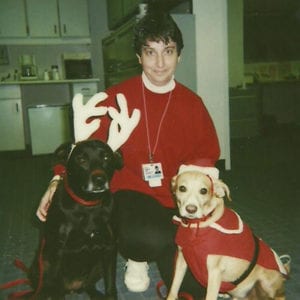 On that day in 1993, inpatient Molly Hicks and her dad were the first to receive a visit from a volunteer dog. It was a milestone for Cincinnati Children’s and a special memory for the Hicks family – a moment in time, captured here in this Polaroid picture from the hospital’s history book.
On that day in 1993, inpatient Molly Hicks and her dad were the first to receive a visit from a volunteer dog. It was a milestone for Cincinnati Children’s and a special memory for the Hicks family – a moment in time, captured here in this Polaroid picture from the hospital’s history book.
From humble beginnings, the Dog Visitation Program has grown into one of the largest single Volunteer Services opportunities at the hospital. Today there are more than 50 trained and badged volunteer dogs who, together with their owners, have contributed more than 700 hours of service over the 2015 fiscal year alone. Through regularly scheduled visits, these pups provide comfort and affection to kids and families across Main and Liberty Campus as well as at three neighborhood locations.
The dogs serve two purposes, Edith says. The first is psychosocial. They make the environment more home-like and give families something to focus on beyond their immediate situation. The second is therapeutic. Dogs can help reduce stress and ease tension before a procedure. They’re also used on occasion to help encourage patient participation during appointments in clinics including OT/PT and speech therapy, Edith says.
“Dogs are always engaging. They don’t care what you look like or what your medical illness is. They love you no matter what,” Edith says. A dog lover herself, Edith and many of her beloved pets have been active participants in the Dog Visitation Program since she helped establish it two decades ago.
When Edith began working in research at Cincinnati Children’s nearly 27 years ago, there was no formal pet or animal assisted therapy offered at the hospital. Even personal service dogs were uncommon then. But Edith understood the intrinsic value of animal assisted therapy and she worked hard to demonstrate that such a program could be possible, from both a logistics and infection control standpoint.
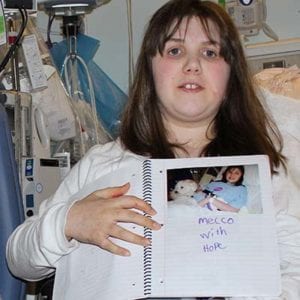 Thanks to Edith’s vision and the efforts of hundreds of volunteer pet owners in our community over the years, the Dog Visitation Program helped pave the way – one paw at a time – for animal assisted therapy at Cincinnati Children’s. The success of the program arguably helped spawn similar initiatives such as the Family Pet Center, opened in 2013, and ushered in full-time facility dogs, Drummer and Leica, in 2016.
Thanks to Edith’s vision and the efforts of hundreds of volunteer pet owners in our community over the years, the Dog Visitation Program helped pave the way – one paw at a time – for animal assisted therapy at Cincinnati Children’s. The success of the program arguably helped spawn similar initiatives such as the Family Pet Center, opened in 2013, and ushered in full-time facility dogs, Drummer and Leica, in 2016.
Taking photos with the dogs during visits continues to be a well-loved tradition by patients, families and volunteers alike. Times and technology have changed since 1993, but the idea remains the same – improve the patient experience. Because for kids like Hope (pictured right), who keeps a journal of every volunteer dog she’s ever had the pleasure of meeting, a positive memory of a hospital visit can make all the difference.
Now, we’d like to point the camera at some of our amazing volunteers. Check out their snapshots below and be on the lookout next time you visit one of these locations:
Pixie, a three-legged pup, and her owner Gail Webb have volunteered for a little over a year in Physical Medicine and Rehabilitation. One of Gail’s favorite memories involves working with a toddler who was rehabbing his arm. He was having trouble using his arm and hand until Pixie sat down beside him to let the boy pet her. It worked, and the boy began to laugh out loud. “That is the happiest he has been since we got here,” the little boy’s mom told Gail.
Gus and his human, Brittani Ristau, often visit Behavioral Medicine and Clinical Psychology patients at Green Township. Gus spends time with a group of 5-10 adolescents and pre-teens in their activity room. Many of the patients have experienced bullying and may feel like they are not good enough. Gus loves them each unconditionally and reminds them that they are great the way they are. Brittani shared, “We are so lucky to have the opportunity to meet and visit with so many different kids. It’s awesome to be able to use some of our free time to serve others, but it’s therapy for us too, and we love it!
Anna Steinmetz and her toy poodle, Stewart, are hard to miss on their visits. With his hot pink coat and sweet personality, Stewart has made lots of friends while comforting countless children and families. Anna remembers a patient who had been in the hospital for a while and her child life specialist let Anna know that the patient was pretty down that day. When she and Steward walked into the patient’s room and he jumped into bed with her – snuggling immediately – the girl laughed so hard she was almost crying. Her mom said it was the happiest her daughter had been since she got to the hospital. And really, who wouldn’t want to snuggle with a pink poodle!
During an afternoon appointment in Orthopaedics at Mason Campus, Amelia and her family were discussing possible surgeries. Amelia’s anxiety was high, her mom says, until they met volunteer Bob Kehm and his dog Jake, a Newfoundland. “Amelia absolutely melted and loved on Jake, completely forgetting any worry,” her mom remembers. “Amelia is Jake’s biggest fan, and we are Bob’s biggest fan.”
Editor’s note: Patients and families can request time with a volunteer dog by contacting their nurse or Child Life Specialist. Dog owners wishing to volunteer with their pets should apply online. Behavioral evaluations take place once per year, usually in January or February.

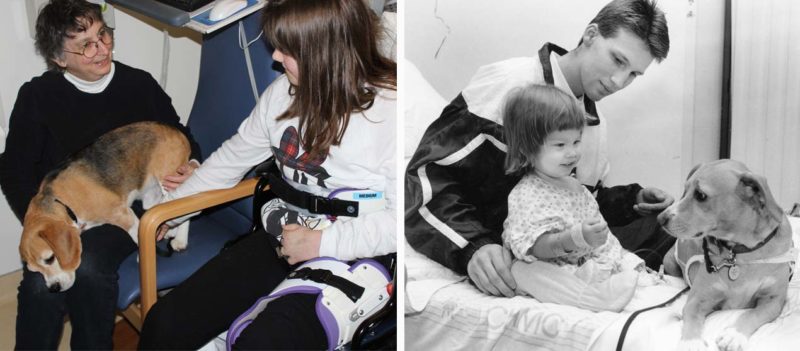

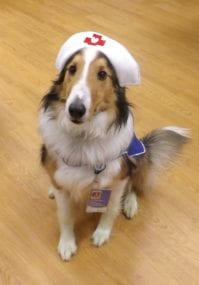
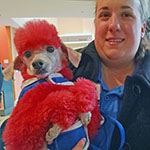
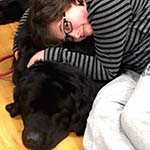
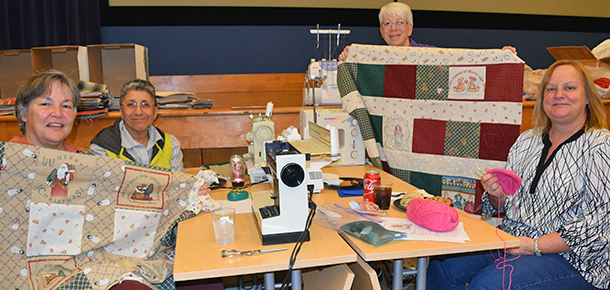
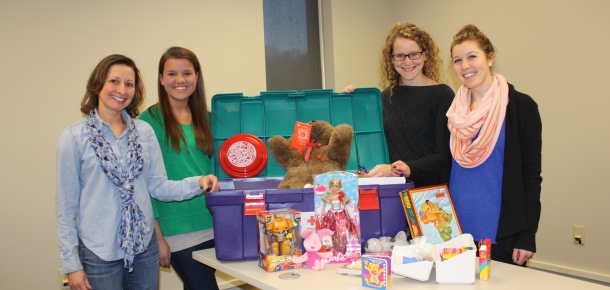
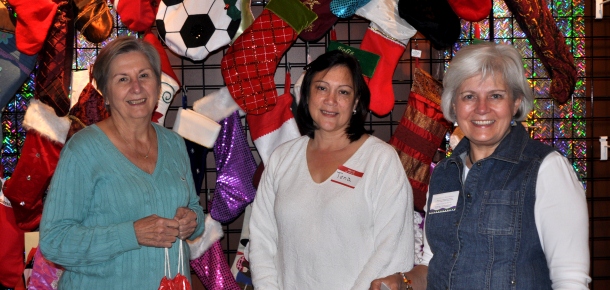
Bravo to Edith and her dedication to a wonderful program at CCHMC! I had two therapy dogs ( both deceased), Moe, a lab, and Wilbur, a standard poodle. I’m not sure who enjoyed visits more…..the dogs, the patients, or the owners of the dogs? I really miss my visits to see the children and the dogs interact. Watching the patient’s faces when a dog appeared……smiles, stress gone…..fantastic!